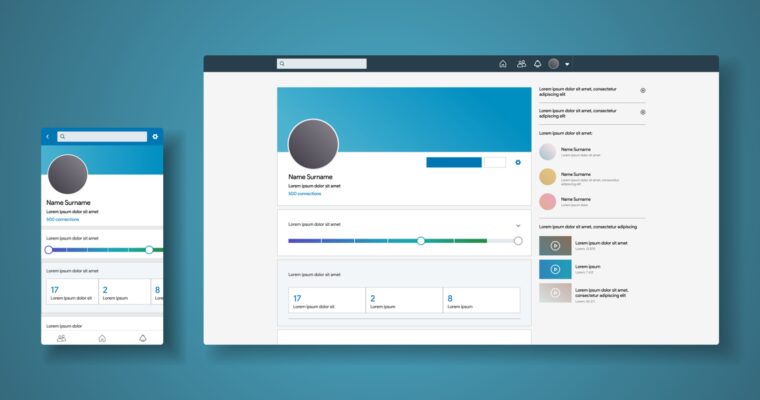
LinkedIn Rolls Out Sales Navigator Search & CRM Card Updates
LinkedIn has announced a series of updates to its Sales Navigator platform designed to help users find leads faster and boost efficiency.
The New LinkedIn Sales Navigator Search Experience
The first update comes in the form of better visualization in the Search experience.
When you go to the search toolbar, LinkedIn Sales Navigator will now show all available filters.
Additional options that will show include “Company Headquarters” and “TeamLink connections of”.
When filtering for your target audience, the results will update in real-time. This update makes finding your target audience or accounts easier and less time-consuming.
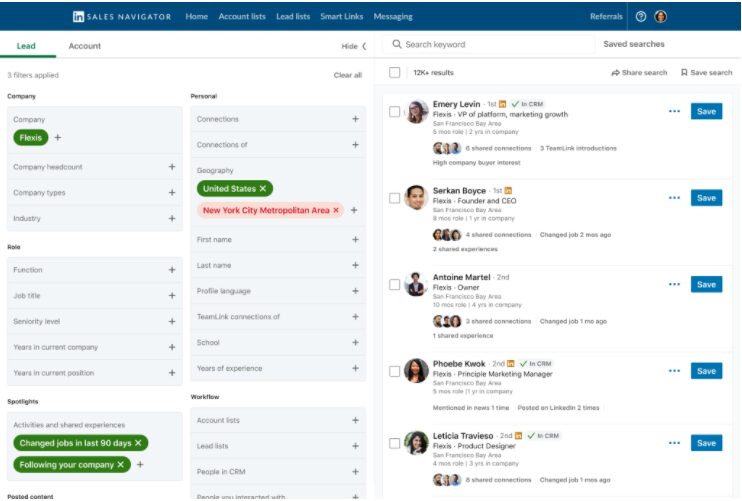
Sales Navigator & CRM Integration Updates
The second feature enhancement from LinkedIn Sales Navigator is for Advanced Plus users.
Sales Navigator can already link to your CRM system (via Microsoft Dynamics 365 and Salesforce) to manage contacts. LinkedIn has added a new tool to this integration called “At-Risk Opportunities” list.
This feature provides a report of people who have left open opportunities, directly into Sales Navigator.
The benefit of this feature helps you prioritize your efforts during critical times, as well as improve your pipeline quality.
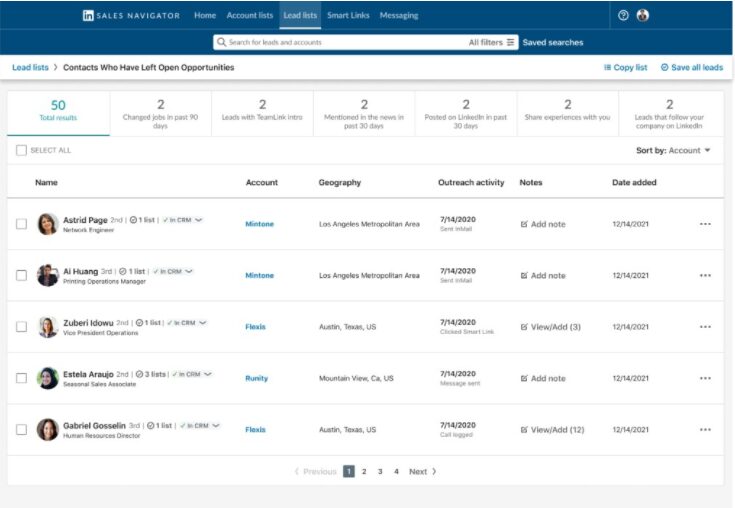
Enhanced CRM cards is another update to the CRM integration. These enhanced CRM cards are added to Account Pages and Contact pages, minimizing the need to toggle between platforms.
The New Homepage Features
The last feature announced by LinkedIn was updates to the new Homepage, which was launched last quarter. The Homepage was a welcome addition to sales teams that shows customized insights for key accounts.
LinkedIn has updated the Alerts Feed, Priority Accounts section, and added a new “Bookmarked Alerts” tab.
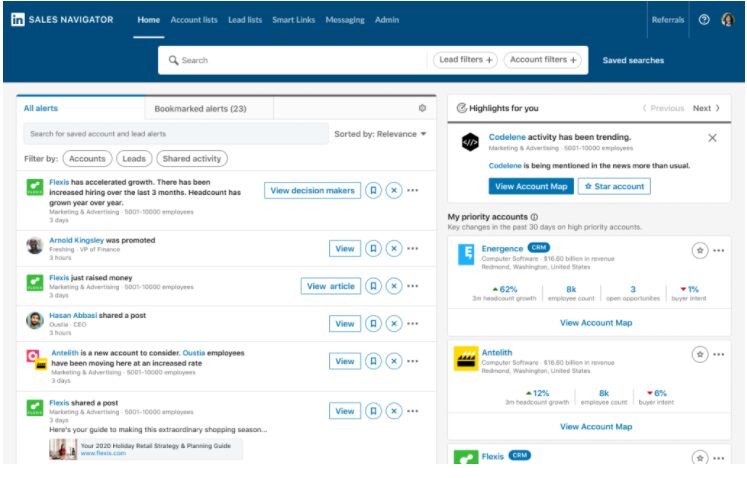
With the Priority Accounts section, you are able to upload accounts that are most important to your business. For example, with so many people shuffling companies or professions, you’re able to keep tabs on when employee or headcount growth.
Source: LinkedIn Rolls Out Sales Navigator Search & CRM Card Updates
SparkPost Global Survey reveals 74% of marketing leaders concerned with impending privacy changes
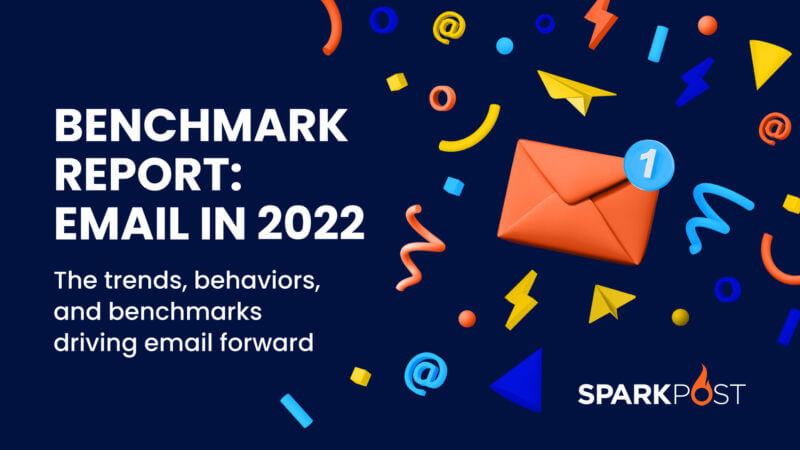
SparkPost, the world’s largest email sending and optimization platform delivering nearly 40% of the world’s email, released its annual email benchmark report, titled Email in 2022: The trends, behaviors, and benchmarks driving email forward. The report closely examines how digital marketers and email marketers have adjusted two years into the pandemic and what digital marketing strategies they’ve leaned on to accelerate growth and connection with key audiences.
Email in 2022: The trends, behaviors, and benchmarks driving email forward
The marketing leaders survey found that, while businesses are showing a strong rebound from two challenging years, they are very mindful of how privacy can and will affect their future digital marketing success. The good news is most leaders recognize the importance of investing in aligning each marketing discipline, shoring up solid data practices, and bolstering their arsenal of branded content and communications channels.
2021 proved most businesses have recovered economically
Businesses, for the most part, are bouncing back to pre-COVID levels, but marketing leaders are more mindful of where dollars are spent. Last year, only 42% of leaders were optimistic that economic recovery was within reach. Now, 63% report their budgets and priorities reflect pre-COVID levels. They are also investing in building out content and branding, which points to organizations knowing the value of investing in themselves.
Email marketing continues to perform as a trusted channel, delivering against the bottom line
In years past, email marketers have been viewed as siloed parts of the marketing organization, but the tide is turning in a major way. Alignment across all marketing channels has skyrocketed in importance to marketing leaders in the last year, with 95% of leaders noting email marketing specifically is more tightly aligned with the marketing ecosystem compared to last year.
Privacy-related changes and challenges continue to worry marketers
The overall fragility of privacy – regulations, consumer behavioral shifts, and big changes coming from the likes of Apple and Google – are having both short and long-term implications on business. Changes in privacy regulations and a shift in consumer perception of personal data are a big factor in marketing leaders’ commitment to invest in earned and owned marketing channels.
Future of work success and employee happiness hinge on improved collaboration and communication
Globally, nearly half (49%) of companies are still fully remote; 41% are hybrid. When asked if they love it, hate it, or are indifferent to working remotely, 85% of marketing leaders say they love it; 90% of practitioners agree. Despite significant workload increases, it’s clear most companies have rebounded financially, and the increased investments in hiring and collaboration tools are allowing workers to succeed, mitigating frustrations, bottlenecks in work, and redundancy. To see detailed trends, more survey results and email benchmark data, download the full report.
Source: SparkPost Global Survey reveals 74% of marketing leaders concerned with impending privacy changes
Content Marketing Priorities for B2B & B2C in 2022
According to results of the study, these are the top priorities for content marketers.
More Money, Bigger Teams
B2B and B2C companies have small in-house teams or use a bevy of freelancers or content agencies to create content, so they can focus on running the business.
Among those surveyed by Parse.ly, nearly 80 percent had content teams of 10 or fewer.
Companies are creating more content than ever, but they recognize the need to create even more new and diverse content:
- 52 percent planning to increase their number of content creators.
- 66 percent planning to increase their content output.
B2B And B2C Content Priorities
Content-savvy companies use content throughout the buyers’ journey from top-of-funnel processes to past checkout.
In the B2B spectrum:
- 91 percent use content for brand awareness
- 85 percent to generate demand and leads
- 81 percent to build credibility
- 79 percent to educate the audience
- 68 percent to nurture leads
- 64 percent to generate sales
In the B2C space
- 84 percent use content for brand awareness
- 78 percent to educate the audience
- 73 percent to build credibility
- 60 percent to generate leads
- 60 percent to build loyalty
- 56 percent to generate sales
Getting The Word Out
Owned channels, such as company websites and social media, are the most popular methods of distribution with 90 percent and 83 percent of respondents.
Emails to listed customers were the third most popular with 77 percent of businesses, followed by paid social media and search ads at 62 percent and 49 percent, respectively.
Both B2C’s and B2B’s first choice for social media platforms was LinkedIn, which according to Parse.ly, brings in about 1 percent of overall social media traffic to a website.
Facebook was the second most popular method of paid and organic distribution and brought in 89 percent of traffic from social media sites.
Popular social media sites such as Instagram and Tik Tok were near the bottom of the list in both paid and organic for business’s preferred platforms.
B2B And B2C Wish List
The most common and easily created content is written, such as blogs and social media posts.
They successfully engage audiences, and blogs do well in search engines, but both B2C and B2B companies wanted to invest in video and longer form content if they had the resources.
Video on YouTube, Facebook, and other platforms whether organic or paid has high engagement.
What’s Working And What’s Not
One of the biggest pitfalls to existing content strategies is understanding the return on investment. According to the report, 51 percent of companies track and understand metrics, while 49 percent don’t understand how their content performs.
The biggest metric used to determine performance is page views, which many get from Google Analytics. Businesses may keep an eye on page views, but don’t track how content impacts sales, revenues, conversions, or the buyer’s journey.
The Outlook For 2022 And Beyond
According to the Parse.ly report, 2022 is a big year for expanding content teams and variety, but the existing legacy tools aren’t equipped to handle the intricacies of content metrics.
Source: Content Marketing Priorities for B2B & B2C in 2022
Google Ads API v10 is now available
Google has released v10 of its Google Ads API, the company announced Wednesday. In order to use some of the new features, advertisers must upgrade their client libraries and client code. Updated libraries and code examples will be available next week.
The new features. Updates in v10 of the Google Ads API include, but aren’t limited to:
- Smart Campaigns are now out of beta and generally available.
- Performance Max campaigns now support asset group signals.
- Support for Local Services Ads campaigns as an open beta.
- Addition of the Audience resource, which can be used as a criterion type.
- Addition of a new
ExperimentService, which replaces the deprecated campaign experiments. - Addition of a new meta parameter,
omit_unselected_resource_names, which can be used to makeGoogleAdsServicereturn only resource name fields that you explicitly request in theSELECTcause of your query.
Source: Google Ads API v10 is now available
Bing’s New PubHub Offers Millions Of New Site Visitors
Microsoft announced the launch of PubHub, a new part of Bing Webmaster Tools that helps news publishers significantly extend their reach and attract more readers.
PubHub for News Publishers
PubHub is a new way for all news publishers, regardless of size, to dramatically increase their readership. The only prerequisite is for the publisher to already be signed up with Bing Webmaster Tools.
The goal of PubHub is to help high quality news sites to be discovered by millions of new readers by exposing their content at different points where an audience may be interested in consuming news content.
Which News Sites Will Qualify?
Bing listed four qualities they are looking for in a news site to feature through PubHub.
- Newsworthiness
- Originality
- Authority
- Readability
Newsworthiness
Bing notes that qualifying news sites must cover events and topics of interest that are actual news. Topics such as advice columns, how-to, weather, and stock information do not qualify.
Originality
When multiple organizations are reporting the same thing, Bing states that originality like facts, analysis and points of view are important.
Authority
News content must have citations to sources and provide thorough attribution, including author information.
Readability
Bing requires that sites not have intrusive advertising and that the content feature good grammar and spelling.
New Opportunity to Increase Readers
The new PubHub offers an opportunity for publishers who put the effort into creating quality reporting to be rewarded with more readers.
This is a win-win-win for Bing because it makes it more useful, for high quality publishers because they will be rewarded for their efforts and lastly it will be a boon for content consumers who will be exposed to more high quality journalism.
Source: Bing’s New PubHub Offers Millions Of New Site Visitors
More News:
Facebook Shifts Focus To Short-Form Video After Stock Plunge
Neeva seeks to expand user base with free subscriptions
Instagram Subscriptions Let Creators Make Monthly Recurring Income